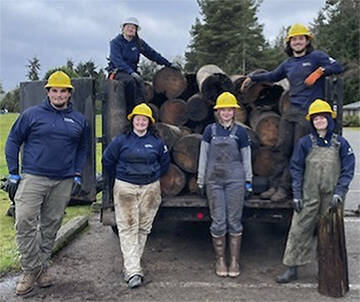Two of Bainbridge’s most popular beaches received a serious New Year’s cleaning after work crews removed 11 tons of toxic waste.
The Bainbridge Island Metro Parks and Recreation District partnered with the state Department of Natural Resources for about two weeks to clean up Fay Bainbridge and Lytle Beach parks, collecting 22,000 pounds of creosote-contaminated debris.
“Most creosote-treated wood on our beaches are a result of dock pilings that have broken off larger structures, making their way to shorelines throughout the Puget Sound,” said Andrew Hacker, DNR restoration specialist. “When produced, the industry standard for creosote-treated pilings was at least 1 gallon of chemical per linear foot, which means our team can approximate hundreds of gallons of chemicals were removed from this stretch of beach.”
A crew of six Washington Conservation Corps members did the cleanups, but it’s hardly a one-off job. The crew travels all over the state removing marine debris, with special emphasis on creosote-treated wood-littering shorelines. Right now, they’re working on Whidbey Island, Hacker said.
Once a common preservative used to weather-proof wood structures like telephone poles, railroad ties, piers and docks, creosote has become a pervasive source of pollution in Puget Sound. When exposed to sunlight, the 300 or so chemicals in creosote become more toxic, leach into the environment and decimate marine species.
“While creosote-treated wood is not good in any form, derelict creosote-d wood debris that is diffused on the shoreline has a much higher potential to mobilize chemicals into our nearshore environment through tidal abrasion,” said David Harry, BIMPRD park services superintendent.
The substance is so toxic that just inhaling vapors of creosote on a hot day can be a threat to human health — let alone direct contact made by sitting on or playing around the wood. Safe and complete removal requires special training, and the DNR advises against citizens attempting to handle contaminated wood themselves, Hacker said.
But even with training, creosote removal comes with challenges. Diffuse debris, or loose chunks of wood that wash up on shore, are pushed around by tides and waves — along with all manner of other beach flotsam. When beach environments are altered by big swells and storms, creosoted wood can be strewn away from where it was originally reported.
“Because of this dynamic, some of the challenges we encounter are tracking down the debris before it moves, or being buried underneath a large pile of natural driftwood or detritus,” Hacker said. “Occasionally large creosote-treated debris will wash up, such as some largely intact dock sections or multiple pilings that are cabled together, which can take some considerable time and effort to remove.”
The southern tip of Eagle Harbor is home to a former creosote plant, which became a federal Superfund site in 1987. “Considerable time and effort” has gone into controlling the contaminated soils and groundwater at the site, and while much has been eliminated, the U.S. Environmental Protection Agency is still working on securing the north and east beaches. Eventually, the site will become a public park.


